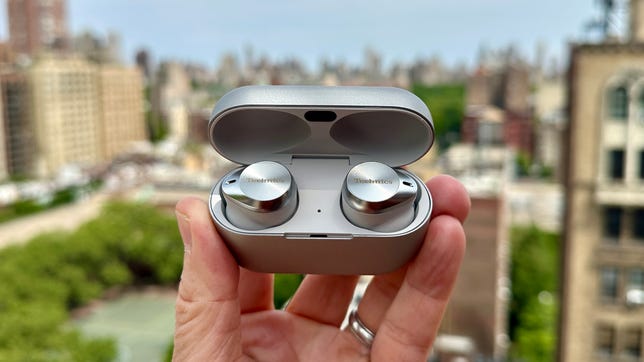Technologies
Technics EAH-AZ80 Review: Are These the Best New Earbuds of 2023?
Technics’ new $300 flagship earbuds get almost everything right with an upgraded, more ergonomic design, plus excellent sound, noise canceling and voice-calling capabilities.
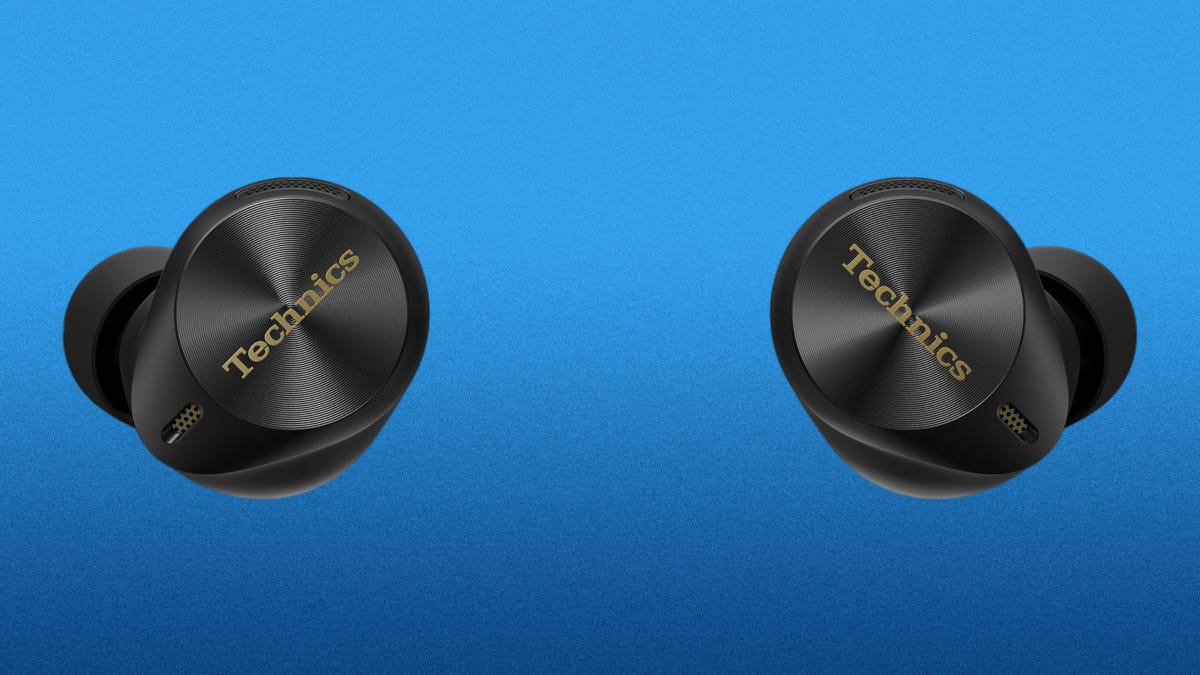
Like
- Stellar sound and very good noise canceling with improved fit
- Good battery life
- Can pair with three devices simultaneously
- LDAC audio codec support for Android devices
Don’t like
- Pricey
- Voice-calling performance is decent but could be slightly better
At the time I’m writing this review, Sony is gearing up to release its rumored and much-anticipated WF-1000XM5 earbuds, the follow-up to its excellent XM4s that earned a CNET Editors’ Choice in 2021. Those upcoming Sony buds — presumably dubbed the WF-1000XM5s — are considered the odds-on-favorite to be the top earbuds for 2023. But wait! Another Japanese company, Panasonic, has released a surprise contender, the EAH-AZ80, under its flagship Technics brand. These are next-generation earbuds that not only sound terrific but feature very good noise canceling in a more ergonomic design. They’re available in two color options — black or silver — and carry a list price of $300.
Equipped with Bluetooth 5.3, the EAH-AZ80s have just about everything you’d want in a set of earbuds, including wireless charging, support for Sony’s higher-resolution LDAC audio codec for Android and other devices that support it and the ability to pair with up to three devices simultaneously (Panasonic says this is an «industry first» for multipoint pairing). But more on all that in a minute. Let me start with my one small gripe, which may not apply to you — and your ears — but could impact some people.
Read more: Best Wireless Earbuds for 2023
Improved fit (mostly)
Panasonic learned something from its previous earbuds, which included the EAH-AZ70W that I reviewed favorably back in 2020. Due to their shape, they didn’t quite nestle in my ears as well as they probably should have and some people complained that they put pressure on certain parts of their ears after using them, for a little while. That’s changed with this model as Panasonic has revised its design to betterconform to the natural shape of your ear, particularly that part of the ear called the concha.
The EAH-AZ80s now nestle in my ears better, fitting more comfortably and securely. My only issue was that I was sort of in between a large and extra-large ear tip — six sizes are included — and the shape of the ear tip wasn’t quite perfectly suited to my ears (I had the same issue with Sony’s WF-1000XM4 buds). I was able to get a tight seal, but the more compact AirPods Pro 2 and new Beats Studio Buds Plus fit a little more comfortably.

The EAH-AZ80s nestle better in your ears than their predecessors.
Since I review so many earbuds, I’ve got a lot of extra ear tips, so I went in search of a better fit and eventually found a set of tips from my collection that worked a little better. The majority of people probably aren’t going to have my problem, but somewhat beefier buds like Sony’s WF-1000XM4 and Sennheiser’s Momentum True Wireless 3 can pose a fit challenge for some people. The EAH-AZ80 aren’t overly weighty for high-performance earbuds but they do weigh 7 grams per bud or just 0.3-gram less than the Sony WF-1000XM4s. They seem fairly sturdy — I dropped a bud onto the pavement as I was walking my dog — and are IPX4 splash-proof so you can run with them (they did stay in my ears while I ran with them, but that may not be the case for everybody).
I thought the touch controls were quite responsive and worked well. You can customize what your taps (or taps and holds) do in the Technics Audio Connect app for iOS and Android, which does offer a wealth of settings options, not so unlike Sony’s Headphones app.
Impressive sound
I praised Technics’ earlier earbuds for featuring very good sound quality. But the EAH-AZ80s take it up a notch on the sound front and are right up there with the very best-sounding earbuds, including the Bowers & Wilkins PI7 S2. These buds don’t feature dual drivers like the Bowers & Wilkins’ buds do, but Panasonic says they have a new 10mm driver with a «free-edge aluminum diaphragm that delivers the greatest sound quality ever from Technics’ true wireless earbuds, extending high and low frequency response while reducing unwanted resonance and distortion.»
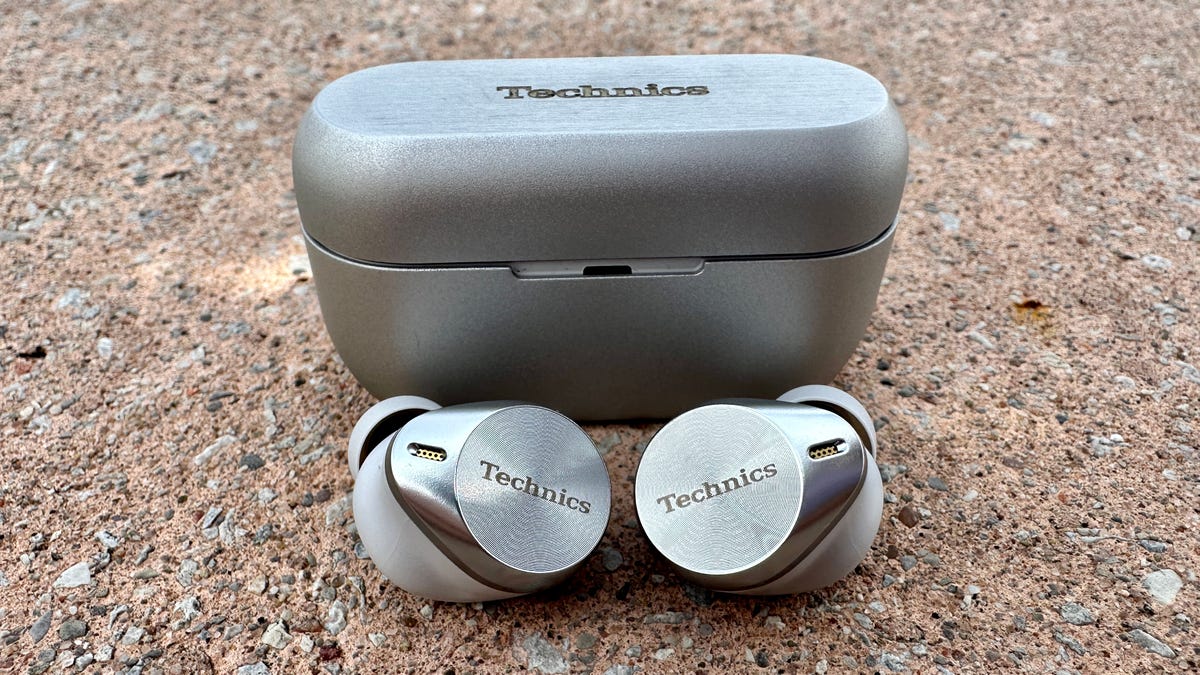
Both the buds and case have a premium look to them.
The clarity and depth to the sound is impressive, and I noticed a slight boost in sound quality when I paired them with a Pixel 7 Pro with LDAC support and a streaming service like Qobuz that serves up high-resolution audio tracks. They also sound excellent with an iPhone 14 Pro, which uses the AAC audio codec, though Qobuz does sound better than Spotify. Note that you have to activate LDAC in Technics Audio Connect app to use that audio codec on Android and other devices that support it.
They lack that extra bit of bass extension that high-end wired earbuds offer, including Panasonic’s own Technics EAH-TZ700 in-ear monitors ($1,200), but for wireless earbuds, they deliver a premium audio experience that measures up to pretty much everything that’s out there in this price range and even higher. You get a lot of earbuds that sound very good for their size, including the AirPods Pro 2, but fewer that feature the accurate sound with extra clarity and three-dimensionality that you expect from pricey headphones.
These are the type of earbuds that allow you to distinguish separate instruments, even in complicated tracks where instruments get mushed together when listening to lesser Bluetooth headphones. Singers’ voices sound natural, there’s good sparkle to the treble (with no sibilance), and the bass is tight. They don’t have quite as much bass energy as the Bowers & Wilkins PI7 but you can kick up the low-end a bit with the bass or superbass boost settings in the Technics Audio Connect app if bass is your thing. (I test bass with tracks like Spoon’s Knock Knock Knock, Athletes of God’s Don’t Want To Be Normal, Orbital’s Dirty Rat and sometimes throw in Taylor Swift’s Vigilante Shit for good measure, because my kids tell me she’s kind of popular.)
Beyond the handful of preset EQ modes in the app, you can also create your own custom equalizer setting. I mainly stuck with the default signature sound setting because it sounded just fine.
Note that Panasonic has also released a new step-down model to the EAH-AZ80 called the EAH-AX60M2. They feature the same features as the EAH-AZ80 but have smaller 8mm drivers and are missing the ergonomic design upgrade found on the step-up model. I have not tried them yet, but they list for $50 less and I suspect will be discounted to less than $200 in the not-so-distant future. I’d personally advise you to pay the extra money for the EAH-AZ80 buds.
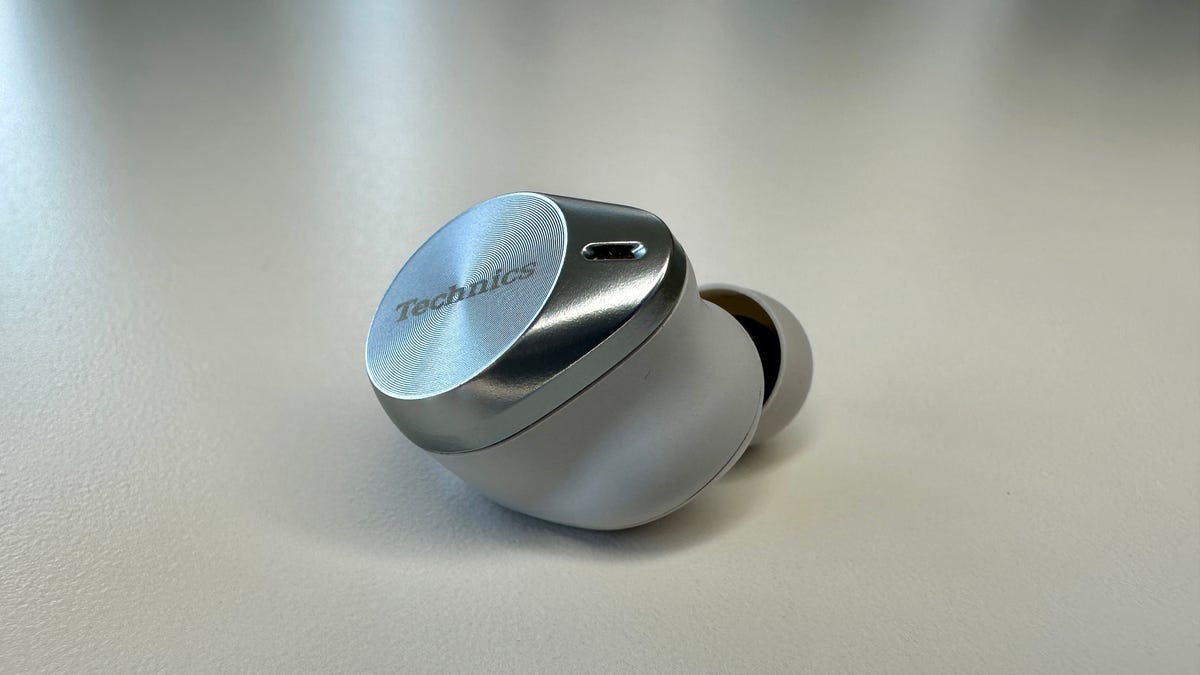
The buds’ new design conforms to the natural shape of your ear.
Upgraded noise canceling and improved voice-calling
When it comes to noise-canceling for earbuds, Bose and Sony are at the top, with Apple nipping at their heels. It’s always really hard to say which company’s noise canceling is better — or best — but the EAH-AZ80 features excellent noise canceling with a couple of ambient sound modes (Apple calls it a transparency mode) that lets ambient sound in and allows you to hear the outside world.
I spent a few days commuting on foot in the streets of New York and the buds reduced what seemed like about 85% of the noise around me. Some higher pitched frequencies leaked in (I could hear people’s muffled voices) but traffic noise was muted to a nice degree, as was the rumble of trains in the New York City subway. I don’t think these are quite on the level of the Bose QuietComfort 2 earbuds, the current gold standard for noise canceling, but they seemed right there with Sony WF-1000XM4 and AirPods Pro 2 in terms of their noise muffling capabilities. (I am assuming Sony will raise its noise-canceling game with the arrival of the XM5s, however.)
In the app for iOS and Android, you’ll find a noise-canceling optimizer option that you can engage (I ended up jacking it up to the Max setting whenever I was outside). There’s also an option in the app to run a test to hear how much background noise is being reduced while you’re making a call. Also, you can opt for a «normal» noise reduction setting and a «strong» noise-reduction setting (at the strong setting your voice quality suffers a bit).
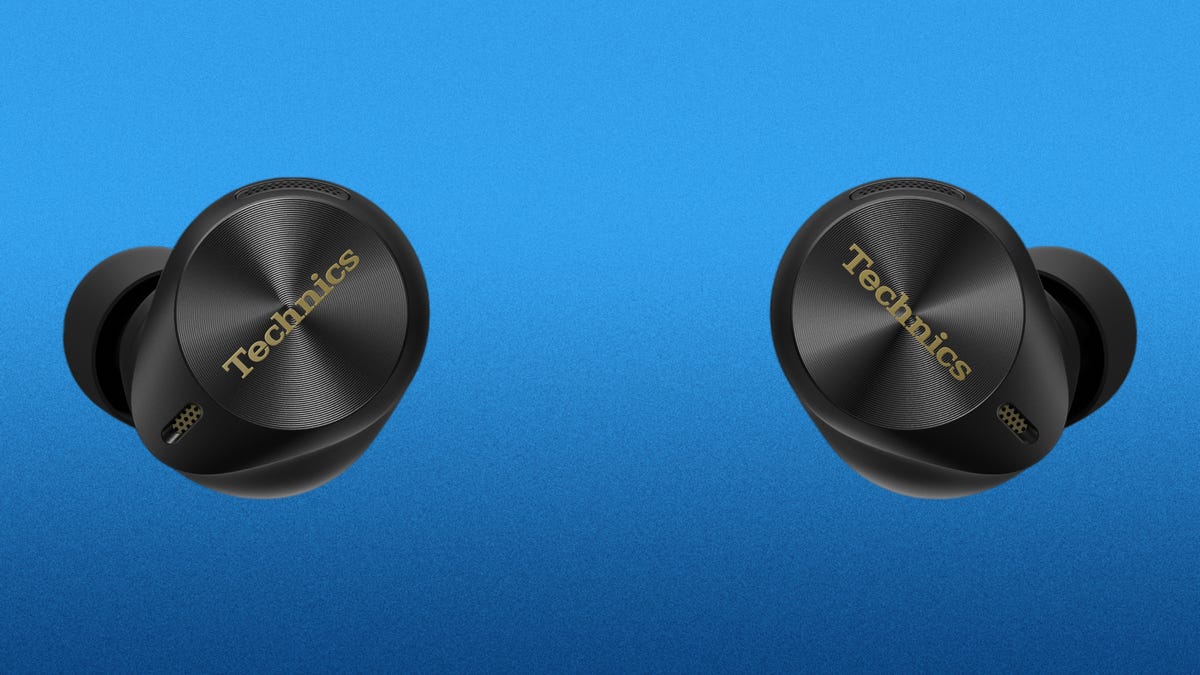
The Technics EAH-AZ80 is shown in black.
Panasonic says its improved JustMyVoice technology «uses eight high-sensitivity MEMS mics, a sensitive voice detection signal, and surrounding noise suppression to capture and transmit your voice clearly.» Callers told me they could hear my voice clearly at the «normal» noise reduction setting but also heard a fair amount of background noise, especially when I spoke. At the «strong» setting, background noise was greatly reduced but I sounded like I was in a tunnel, callers said (I could hear them just fine). I had two people tell me they thought the call quality was reasonably good but not up to what you get with new Beats Studio Buds Plus and AirPods Pro 2. (I did one firmware upgrade already but we may see more as Panasonic tweaks features and performance).
With the AirPods Pro 2, Apple’s transparency mode is on or off and automatically adjusts to the world around you. With these buds, you can manually adjust transparency levels in the app — I found the mode sounded most natural (most like not having earbuds in my ears) when I set it at around 50%. There’s also an Attention mode that you can toggle on, which emphasizes voices so you can hear people talking better in noisier environments.
As I said, the one unique feature is the enhanced multipoint pairing that allows you to pair three devices simultaneously — say a computer, smartphone and tablet. The one caveat is that if you use the LDAC audio codec, you can only connect two devices simultaneously, and it’s really best to have the buds paired to a single device if using LDAC for optimal bandwidth (you make your multipoint/LDAC selection in the app).
While battery life is rated for up to 7 hours playback with ANC on (at 50% volume), I got closer to 6 hours because I play my music at closer to 70% volume. You get a little more than three extra charges from the charging case, which, as noted, can be charged wirelessly or via USB-C. There’s also a quick charge feature that gives you 70 minutes of playback from a 10-minute charge.
Technics EAH-AZ80 final thoughts
One should expect a lot from earbuds that cost $300 — and yes, that’s still a lot to pay for headphones, even if plenty of people seem to be willing to pay upwards of $450 for the likes of Apple’s AirPods Max headphones. Overall, Panasonic has done a nice job of creating an all-around top-performing set of buds that offer an improved fit with excellent sound, very good noise-canceling and a robust feature set.
Voice-calling capabilities are decent but don’t quite live up to their billing (yet). Hopefully we’ll see some firmware upgrades that improve the voice-calling experience in noisier environments. Despite that caveat, as long as they fit your ears well, the Technics EAH-AZ80 are right up there with the best wireless earbuds on the market right now.
Technologies
The Black Friday Gaming Deals You Want Are Already Here, Including PlayStation, Xbox and Alienware
Technologies
The Black Samsung Galaxy Z Fold 7 Is at a Record $443 Off at Amazon for Black Friday
A Galaxy Z Fold 7 price war between Amazon and Samsung gives us a record-low deal for one color.
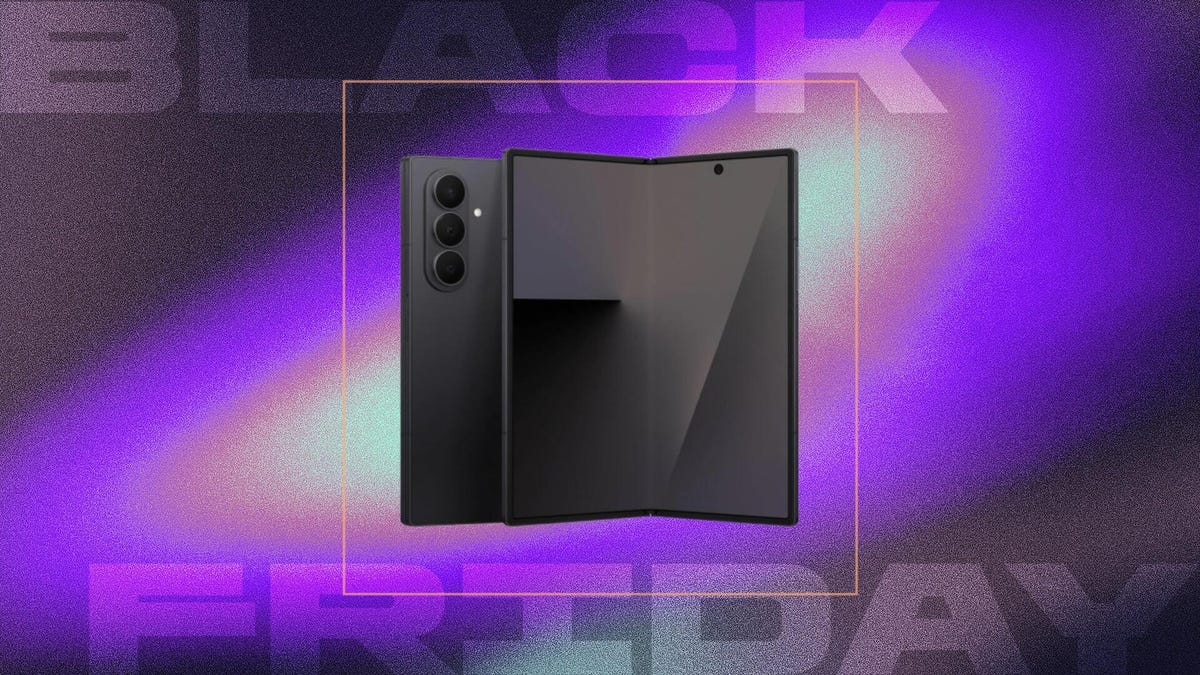
If you’re looking for a foldable iPhone, you’re gonna need to wait until 2026, but if you’re looking for the best foldable phone of 2025, there are great deals on the Galaxy Z Fold 7 right now at both Amazon and Samsung, with the former dropping the black version of Samsung’s foldable phone to a record-low $1,557. All other models are $1,600 at both Amazon and Samsung, a $400 discount.
Samsung’s unique foldable phones had an awkward adolescence, but after getting her hands on the new lineup, CNET reviewer Abrar Al-Heet confirms that the latest Z Fold 7 «just feels right.» For one, it’s incredibly sleek at just 8.9mm thick when closed or 4.2mm thick when open, which is so thin you may even forget that it’s foldable.
Hey, did you know? CNET Deals texts are free, easy and save you money.
Despite weighing just 215 grams, this foldable features some serious hardware. It has a 6.5-inch cover screen and an 8-inch interior display with a fluid 120Hz refresh rate. It’s equipped with a cutting-edge Snapdragon 8 Elite processor and 12GB of RAM to support tons of helpful AI features and functions, and comes with Android 16 and Samsung One UI 8 right out of the box.
The camera system is also pretty impressive, boasting a 200-megapixel rear camera, 12-megapixel ultrawide shooting and a 10-megapixel front camera on both the cover and interior screens. Plus, it’s equipped with a 4,400-mAh battery for all-day use.
MOBILE DEALS OF THE WEEK
-
$749 (save $250)
-
$475 (save $175)
-
$499 (save $300)
-
$900 (save $400)
Why this deal matters
With an unbelievably sleek design and cutting-edge hardware, the impressive Samsung Galaxy Z Fold 7 is our favorite foldable phone on the market. But it also comes with a staggering $2,000 price tag, and if you’re hoping to get your hands on one, this $443 discount is a way to rack up some serious savings and help cushion the blow of its considerable cost. Just be sure to get your order in soon, as we doubt this deal will remain live for long.
Join Our Daily Deals Text Group!
Get hand-picked deals from CNET shopping experts straight to your phone.
By signing up, you confirm you are 16+ and agree to receive recurring marketing messages at the phone number provided. Consent is not a condition of purchase. Reply STOP to unsubscribe. Msg & data rates may apply. View our Privacy Policy and Terms of Use.
Technologies
I Almost Missed This Deal Within a Deal for Baseus’ Bose-Infused Headphones and Earbuds
Baseus’ new Inspire XH1, XP1 and XC1 models with Sound by Bose are 23% to 33% off for Black Friday and Cyber Monday. But Baseus throws in its BC1 clip-on earbuds or other «free» bonus items to make the deal even sweeter.

I gave CNET Editors’ Choice awards to Baseus’ Bose-infused Baseus Inspire XH1 headphones and Inspire XP1 earbuds because they’re well designed and sound decent for what they cost. I also liked Baseus’ Inspire XC1 clip-on earbuds, which have dual- drivers and earned a spot on CNET’s best clip-on earbuds list.
Last week all three models were selling for around $110 (though they have higher list prices), but they’re now discounted to around $100 for Black Friday and Cyber Monday. That’s a deal I’d highlight on its own, but if you click through to any of those models’ Amazon product pages an look closely you’ll see that each is eligible for «one free item» with purchase.
Read more: Best wireless earbuds of 2025
You have to click the «how to claim link» and then add one of the three products to the your cart. Once one of the headphones or earbuds is added to your cart, you can click a button on the left side of screen (above the stars for average ratings) that switches the view from «qualifying items» to «benefit items.» You can then add Baseus’s BC1 clip-on earbuds, which list for $40, to your cart as a free item. Baseus’ step-up Basues MC1 Pro ($48 for Black Friday) and Inspire XC1 clip-on buds sound better, but the BC1 are fine for casual use.
If the BC1 earbuds option doesn’t thrill you, there are other freebies you can opt for. Just go back to the Amazon product page for the Inspire XH1, XP1 and XC1 and you’ll see options for one free item with $100, $90, $51 and $46 purchases. The $90 benefit item is a 30W dual-port fast charger (list price $20), which is decent, and the $51 benefit item is a retractable USB-C cable ($19 list) that’s useful. Don’t bother with the $46 benefit item.
You can read my full reviews of the Inspire XH1 headphones here and the Inspire XP1 earbuds here. And here’s my quick take of the Inspire XC1 earbuds:
Like Baseus’ noise-isolating Inspire XP1 earbuds that I rated highly, the Inspire XC1 feature «Sound by Bose» and a more premium design than earlier Baseus earbuds. The XC1 don’t sound as good as the XP1, but they sound good for open earbuds and are equipped with dual drivers, one of which is a Knowles balanced-armature driver that helps improve treble performance. While they don’t produce as much bass as noise-isolating earbuds like the Inspire XP1, their bass performance is better than I expected. The buds’ sound is pretty full, especially in quieter environments, though they do better with less bass-heavy material (I did notice a bit of distortion at higher volumes with certain tracks with harder driving bass).
While I prefer the design and fit of Bose’s Ultra Open Earbuds (as well as the design of their case) and think the Bose buds sound more natural and a tad better overall, the much more affordable Inspire XC1 fit comfortably and offer top-tier sound for clip-on open earbuds (and they play louder than the Bose), as well as decent voice-calling performance with good background noise reduction.
HEADPHONE DEALS OF THE WEEK
-
$248 (save $152)
-
$170 (save $181)
-
$298 (save $131)
-
$199 (save $150)
Read more: Best Black Friday headphones deals
Join Our Daily Deals Text Group!
Get hand-picked deals from CNET shopping experts straight to your phone.
By signing up, you confirm you are 16+ and agree to receive recurring marketing messages at the phone number provided. Consent is not a condition of purchase. Reply STOP to unsubscribe. Msg & data rates may apply. View our Privacy Policy and Terms of Use.
-

 Technologies3 года ago
Technologies3 года agoTech Companies Need to Be Held Accountable for Security, Experts Say
-

 Technologies3 года ago
Technologies3 года agoBest Handheld Game Console in 2023
-

 Technologies3 года ago
Technologies3 года agoTighten Up Your VR Game With the Best Head Straps for Quest 2
-

 Technologies4 года ago
Technologies4 года agoBlack Friday 2021: The best deals on TVs, headphones, kitchenware, and more
-

 Technologies4 года ago
Technologies4 года agoVerum, Wickr and Threema: next generation secured messengers
-

 Technologies4 года ago
Technologies4 года agoGoogle to require vaccinations as Silicon Valley rethinks return-to-office policies
-

 Technologies4 года ago
Technologies4 года agoOlivia Harlan Dekker for Verum Messenger
-

 Technologies4 года ago
Technologies4 года agoiPhone 13 event: How to watch Apple’s big announcement tomorrow

